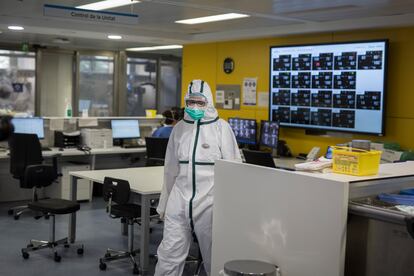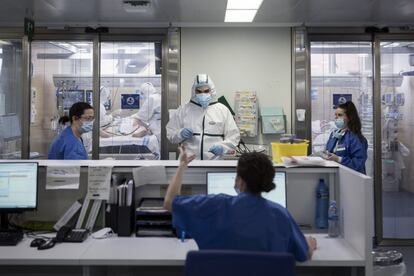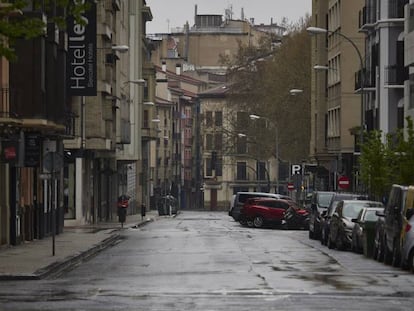Inside a Barcelona intensive care unit: “There are no schedules in war, and there are none here either”
EL PAÍS visited Vall d’Hebron Hospital, which has Spain’s largest critical patient area, to see how medical staff are dealing with the coronavirus pandemic

On either side of a corridor crowded with busy nurses and trolleys, 13 coronavirus patients wired up to monitors are fighting for their lives in a tangle of tubes. None of the approximately 200 beds in Spain’s biggest intensive care unit at Vall d’Hebron Hospital in Barcelona are free. Nor are there reliable statistics. In each bed, patients are fighting for breath. And the critically ill keep coming.
In one screened-off unit with negative pressure to prevent viral particles from escaping into the main ICU area, a middle-aged man battles silently on, the only noise a soft intermittent beep from a distant monitor. Face up, oblivious to the nurses’ movements beyond the glass, he struggles to breathe with the help of a ventilator.
“Pneumonia caused by Covid-19 is practically the only illness being treated in the 13 ICU areas set up in Vall d’Hebron,” says Ricard Ferrer, head of intensive care here. “Patients coming in have respiratory failure in addition to pneumonia, and 90% of cases require intubation and a ventilator. We have people of all ages, from 30-year-olds to people in their late seventies.”
On Tuesday, 168 patients with Covid-19 and a dozen with other conditions were being treated at the hospital’s intensive care units.

Perfect order prevails over the chaos of the pandemic at the hospital. Even though the corridor is busy, everything is in its place. Wearing white and green striped personal protective equipment (PPE), a nurse waits at the doors of one of the screened-off units. Standing outside, a colleague issues voice instructions to help her remove the equipment. Infection is everywhere and the nurses do two-hour shifts in the units to optimize the scarce PPE. “It’s hard to bear more than two hours with the PPE. It makes you sweat. We’re wearing three pairs of gloves and you can’t feel the vein properly when you want to put in an intravenous tube,” says Elia Olivera, an ICU specialized nurse.
Improvisation has become the name of the game and the equipment used to clean the bronchoscopes is now also being used to clean the PPE goggles. “It’s recycling time,” jokes the assistant in charge of the job.
Inside the ICU, it’s hard to recognize the heroes who are applauded each night at 8pm by citizens across Spain. There are no capes or superpowers on display. All you can see are exhausted healthcare workers whose dark circles beneath their eyes are hidden by masks.
At home, I sleep in a separate room and I haven’t hugged my children for a monthRicard Ferrer, head of intensive care
“There are no schedules in war, and there are none here either,” says Antoni Roman, director of healthcare at Vall d’Hebron. The doctors are on 24-hour shifts with two days off in between.
“The shifts are very tough,” says Ferrer. “At home, I sleep in a separate room and I haven’t hugged my children for a month. The distance between us at home is hard, and here at the hospital there is a lot of pressure, a lot of work, and you can see that the patients feel very alone.”
“For the first few days, I was crying all day, but then you get used to it,” says Elia Olivera who is standing in a hemodialysis room that has been converted into an ICU. “We’re pumped with adrenaline. The problems will come later.”
The hospital’s psychiatry team is offering emotional support to professionals and also to the patients’ families. The nursing supervisor of the entire intensive care unit, Pilar Girón, admits that it is difficult to manage the fatigue. “I have never thought ‘I can’t go on,’ but there has been a general feeling of being in a cave and for a while we even kept our gaze down.”

Time in the ICU passes slowly. Patients spend at least two or three weeks here. “The patient is going to need sedation, muscle relaxation and ventilation, which will require a couple of weeks, and then they have to stay for a few more days with a tracheotomy until they recover their muscle strength and the ability to breathe on their own before being moved to another ward,” says Ferrer.
The doctors have set up a system to keep families informed on a daily basis, and when the patient is awake, the nurses try to connect them to their families via video conference. “If there’s a death, you feel the absence of a family member and the loneliness of the patient,” says Girón. “The nurses are always with the patient, but when we see that there is no family present, we try to be there for them even more.”
The ICU is a hostile place. It’s not right for everyone, nor are ventilators a cure-all, according to the experts. Regarding a controversial instruction from the Catalan Medical Emergency System, which endorsed limiting the intubation of people over 80 depending on clinical criteria, the healthcare director at Vall d’Hebron explains that “it is not a question of rights or age discrimination. Entering the ICU is a tremendous challenge; you have to be very strong to spend three weeks there. It is not a question of abandoning anyone, but of offering the most dignified treatment we can, and often that dignified treatment is not about wiring you up to the hospital’s machinery. People come here and think they can be saved from anything, and it’s not true. If the treatment is not going to help them, it’s better not to do it.”
The feeling is like you’re in a funnel and you’re hoping no more water will fall in than you can managePilar Girón, ICU nursing supervisor
Ferrer agrees. “We always select the patients to be admitted to the ICU. The current situation hasn’t changed the fact that we have to assess patients and select only those who are going to benefit from being in intensive care and receiving such invasive and aggressive treatment. The patient must be strong to withstand the severity of the disease.”
Some patients cause differences of opinion regarding their care. For example, one of the women in intensive care is young, but very obese. Her kidneys have failed and she is undergoing a continuous and gentle dialysis, as her body would not withstand the intensity of normal dialysis. “This is a case that is up for discussion because it is going to be hard for this woman to ever breathe on her own,” says Ferrer. The patient is on sedatives, paralyzers and norepinephrine to raise blood pressure. Next to her is another patient with a better prognosis who has also suffered kidney failure and needs hemodialysis. “This is not a flu,” notes Ferrer. “A significant percentage of patients also get heart or kidney damage. It’s not a disease that is cured with just a ventilator.”
At the control table, dozens of monitors show each patient’s condition in real time. Security cameras monitor the individual units and a computer program controls the treatment dosages.
Aside from all the suffering, there is an occasional reason to smile. “She’s one of those sources of joy,” says Ferrer, pointing to a patient who has already been taken off the ventilator and is now talking and breathing on her own with oxygen support. She looks at him straight in the eye, and the doctor opens the glass door that separates her from the world.“How are you doing? Are you feeling stronger? Can you raise your arms?” he asks. She nods and lifts them. Ferrer smiles behind his mask. The patient has regained her muscle strength and will be ready to leave intensive care in a couple of days.
The critically ill continue to be admitted to Vall d’Hebron, and those who are already there will be staying for some time. “The feeling is like you’re in a funnel and you’re hoping no more water will fall in than you can manage,” says Girón.
The doctors warn against anyone letting their guard down. While the rate of admissions to the ICU has slowed down, patients continue to come. “Right now, I’m more concerned about patients who are not Covid-19 cases,” says Ferrer. “So far we have been able to deal with this catastrophe, but right now, if there were an accident with multiple victims, it would be very difficult to cope with. It would find us in a very difficult situation. We have to maintain the confinement measures because we couldn’t treat any more patients requiring intensive care, whether for Covid-19 or any other condition.”
“This epidemic is here to stay,” adds Roman. “Eighty percent of us are going to have to deal with it. We’re going to have to go through it. Now that it’s here, it isn’t going to simply go away and leave us alone.”
English version by Heather Galloway.
Tu suscripción se está usando en otro dispositivo
¿Quieres añadir otro usuario a tu suscripción?
Si continúas leyendo en este dispositivo, no se podrá leer en el otro.
FlechaTu suscripción se está usando en otro dispositivo y solo puedes acceder a EL PAÍS desde un dispositivo a la vez.
Si quieres compartir tu cuenta, cambia tu suscripción a la modalidad Premium, así podrás añadir otro usuario. Cada uno accederá con su propia cuenta de email, lo que os permitirá personalizar vuestra experiencia en EL PAÍS.
¿Tienes una suscripción de empresa? Accede aquí para contratar más cuentas.
En el caso de no saber quién está usando tu cuenta, te recomendamos cambiar tu contraseña aquí.
Si decides continuar compartiendo tu cuenta, este mensaje se mostrará en tu dispositivo y en el de la otra persona que está usando tu cuenta de forma indefinida, afectando a tu experiencia de lectura. Puedes consultar aquí los términos y condiciones de la suscripción digital.
More information
Últimas noticias
Most viewed
- Reinhard Genzel, Nobel laureate in physics: ‘One-minute videos will never give you the truth’
- Oona Chaplin: ‘I told James Cameron that I was living in a treehouse and starting a permaculture project with a friend’
- Pablo Escobar’s hippos: A serious environmental problem, 40 years on
- Charles Dubouloz, mountaineering star, retires at 36 with a farewell tour inspired by Walter Bonatti
- Why we lost the habit of sleeping in two segments and how that changed our sense of time









































